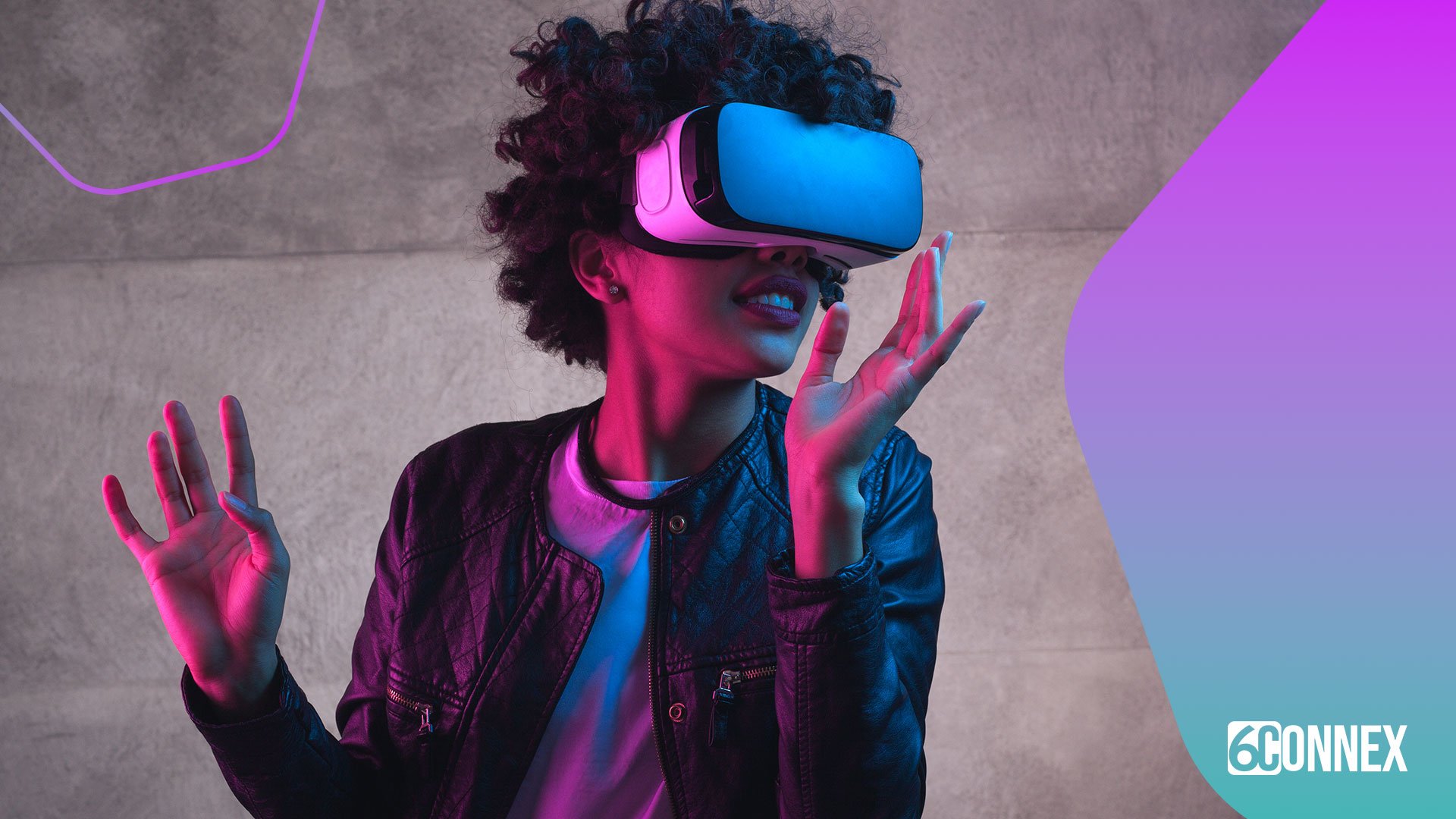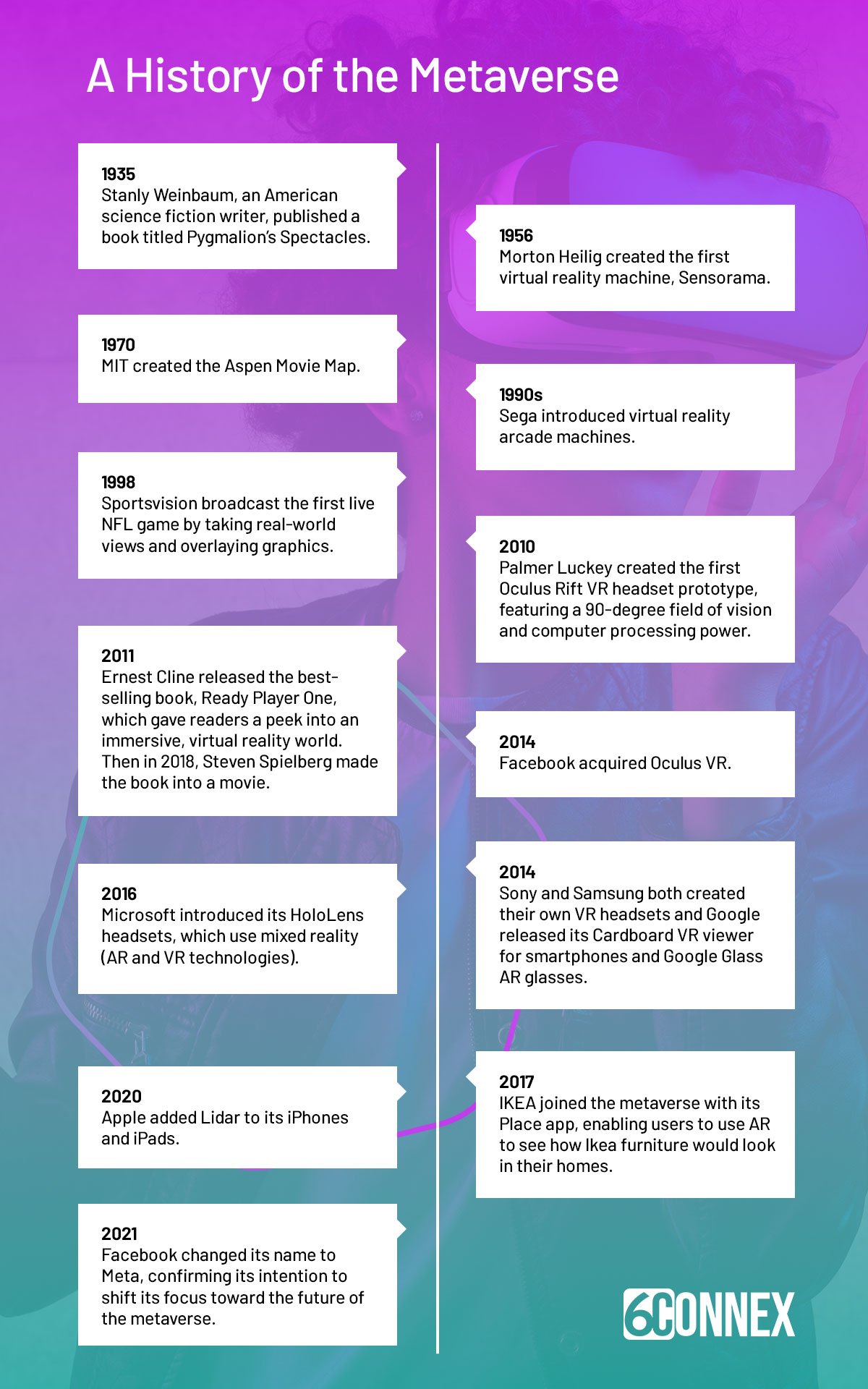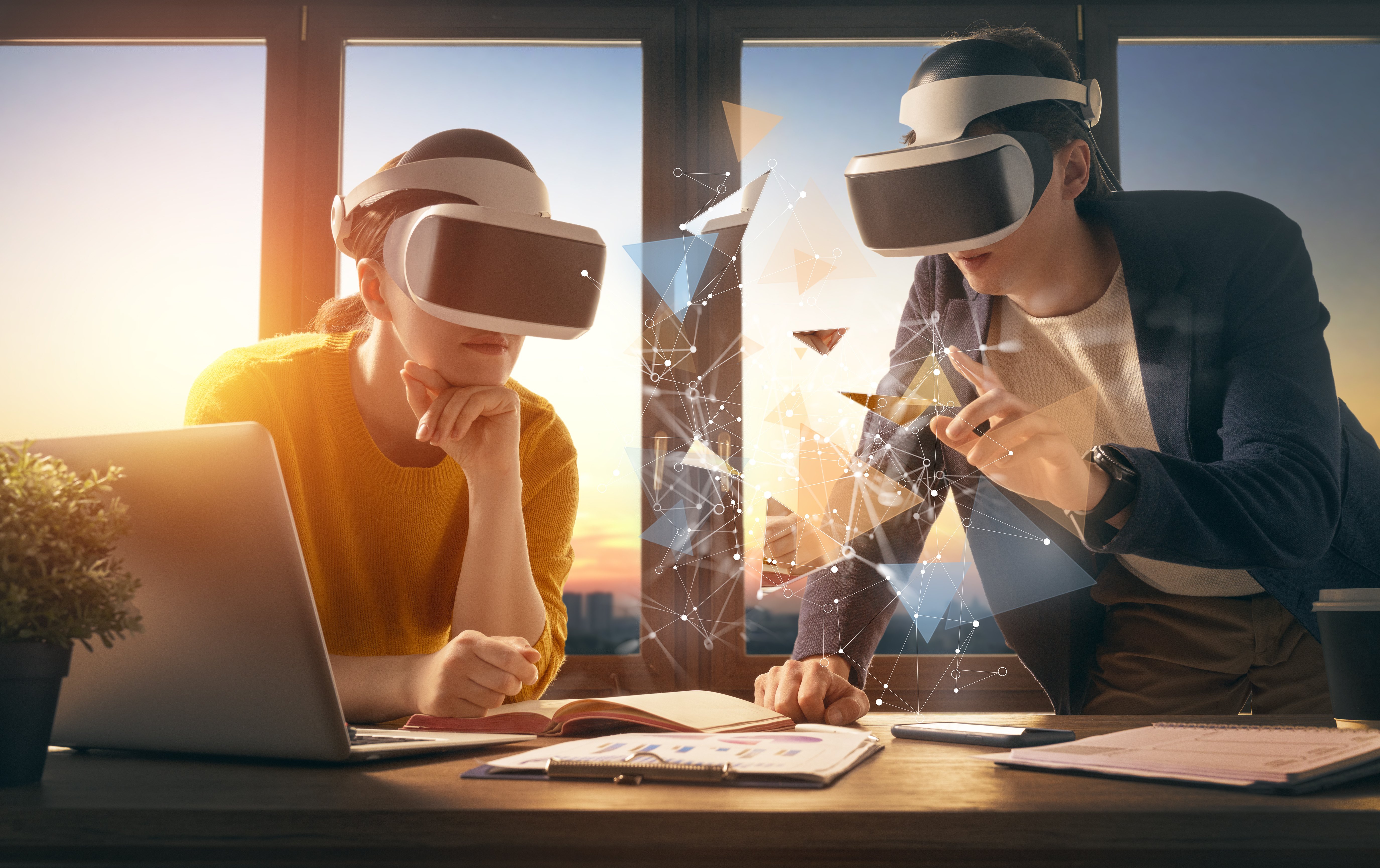So, You Want to Know How to Access the Metaverse: An Introduction to Virtual Reality
Kortney Phillips
Jan 17, 2023 10:00:00 AM

By now you have probably heard talk about the metaverse. And while most people know the metaverse has something to do with virtual reality and the internet, they don’t quite understand how it all works.
Today, we’re going to take a deep dive into the metaverse, answering questions such as, “How does the metaverse work?” and “How do I access the metaverse?” After reading this article, you should understand the metaverse and know how you can use it to your advantage both personally and professionally to build your brand.
The metaverse is a version of the internet in which users, in the form of avatars, enter a single, shared environment to experience an immersive, 3D world that features both virtual and augmented reality – encountering the environment and connecting with others in ways they can’t in the physical world.
The metaverse isn’t owned by any one person. Rather, it’s a virtual, 3D network where everyone can participate. Additionally, the metaverse isn’t just one entity. There are different metaverses created by different people, and anyone can create their own metaverse.
The metaverse is sometimes referred to as Web3 because it is the third generation in the evolution of web technologies. The original internet is considered Web1 (although people have never referred to it this way) and Web2 is the second evolution. Web2 is based on the web as a platform, and it focuses on user-generated content, usability, and interactivity, such as socializing and networking on social media.
Web3 uses different technologies including blockchain and decentralization to change the way people use and interact on the internet, including virtual reality, augmented reality, and cryptocurrency.
Currently, there is no single way to access the metaverse. Unlike the internet, where you have access through your chosen browser, each metaverse must be accessed separately through virtual reality and/or augmented reality enabled devices. You can purchase virtual reality devices, such as Google Cardboard, for a basic metaverse experience. Alternatively, you can purchase a more expensive device, such as the Oculus VR headset or similar, for a better experience.
Virtual reality, sometimes referred to as VR, is a computer-generated 3D environment or image with which you can interact in a seemingly physical or real way. VR simulates the human senses to create an immersive, life-like experience.
VR combines hardware and software to create an experience that makes the eyes and brain believe they are in a physical environment. VR hardware can simulate sounds, smells, touch, heat, etc. while the VR software creates a simulated virtual environment. For example, 6Connex offers a virtual venue platform without the headset. Our immersiv, virtual event solutions is not only fully customizable, but we offer an open universe technology that lets you bring your own solutions. You can sync your virtual environment with your favorite event tech, giving you more flexibility and customization options than the metaverse, without all the hardware.
You can use several VR tools and accessories to participate in a virtual experience:

Virtual reality is an immersive, artificial experience that uses synthetic environments and sensory stimuli, but it doesn’t include any facets of the real world. Augmented reality (AR), on the other hand, uses real-world visuals and digital overlays together to create life-like artificial objects. When using AR, a user views a real-world object directly on a device such as a digital camera. AR technology then superimposes computer-generated audio, video, graphics, and other virtual enhancements.
A good example of AR is when a retailer, paint store, furniture store, or home improvement store enables the consumer to superimpose an image of their home with a product to visualize how the product would appear. To do this, the consumer simply points their digital camera at any given room, etc., and the superimposed product appears in the foreground.
Some examples of how AR can be used in events include:
The metaverse is a virtual reality space where users can interact with others in a computer-generated environment. The metaverse is boundless, dynamic, and persistent, with open and interoperable spaces. It uses decentralized (run by users instead of big businesses) platforms to provide users with amazing, immersive experiences. Think of it as the internet but with 3D virtual reality. Every metaverse offers endless social experiences, each with its own governing system and virtual economy.
The metaverse is boundless, dynamic, and persistent, with open and interoperable spaces.
Believe it or not, the metaverse isn’t new. Metaverse history began in 1838 when a scientist named Sir Charles Wheatstone developed the concept of “binocular vision,” which combined two images — one for each eye. These combined images created a single 3D image. This concept then led to technology that used the illusion of depth to create an image, which is used today in modern VR headsets. From there, various metaverse milestones were achieved:

It will be interesting to see what comes next and how the metaverse will evolve.
The metaverse is a new technology that enables user-to-user interactions. Event planners can leverage the metaverse to host virtual events for their clients, and other industries are using the metaverse to introduce new training, marketing, and sales strategies.
The metaverse is poised to be the next internet. It will transform the way people interact with each other and with information in general.
There are different layers that create a metaverse experience.
1. The Experience Itself: The metaverse enables users to perform a variety of activities in a 3D environment. This layer removes all physical limitations because space is dematerialized in the digital world.
2. Discovery: This layer uses search engines, app shops, and rating websites. These allow a user to learn about the different platforms. It provides users with a more enriching experience through social curation, ratings, and stores inside the metaverse.
3. Creator Economy: The metaverse encourages and enables creators to produce digital assets and experiences. It also allows developers to design unique and essential tools and apps. Anything designed and developed can then be put on any given metaverse marketplace while the creator maintains complete control over the ownership and management of their assets.
4. Spatial Computing: There are a variety of spatial computing components that comprise the metaverse. These include VR, AR, 3D engines, geospatial mapping, and multitasking UIs. The combination of these components helps provide a more immersive experience within any given metaverse.
5. Decentralization: Decentralization provides independent experiences for all users. This means there isn’t any single authority that rules the metaverse. Rather, the metaverse is composed of scalable ecosystems that support business owners by providing them with complete ownership of their specialized digital data and assets, all of which are enabled by blockchain technology.
6. Human Interface: There is a hardware layer in the architecture of a metaverse that uses an avatar, which can be a 3D image of the user or of something else, which enables access to the metaverse and delivers a personalized, immersive experience.
7. Connectivity: Connective technologies are required to access the metaverse. You must have the necessary infrastructure in place to participate in any given metaverse. This could include 5G, Wi-Fi, cloud computing, GPUs, or other computing resources, all of which connect the user to the metaverse and provide a seamless, fluid metaverse experience.

The metaverse is used for more than you would think. The metaverse began as a gaming environment but has quickly evolved into an all-purpose tool many industries use for various objectives.
Education and Company Training: VR is now commonly used in employee training and requires the use of a headset. Using virtual reality enables the employee to learn using real-world experiences at home or at the office.
Healthcare: Healthcare practitioners can use VR to simulate issues to help patients with various disorders. Medical students can also use it to practice surgery and other procedures in a virtual environment.
Travel: Hotels and vacation destinations can use VR to give prospective guests a life-like tour of their accommodations or of popular hot spots in a 3D environment (as opposed to watching a video or viewing photos).
Real Estate: Developers, city planners, real estate agents, property managers, etc. can all use VR to give prospective buyers and tenants a simulated look into the project or space they are considering.
Retail: Retailers use VR to help potential consumers “try before they buy” clothing, products, services, etc.
Military and Law Enforcement: VR is used by the military and law enforcement to simulate combat and confrontations. This allows them to virtually practice dangerous, life-like exercises without any injury or life-threatening consequences.
Entertainment: VR enables users to virtually attend concerts, sporting events, horse racing, and other games and to interact virtually with their favorite entertainers and teams in a highly personalized way.
Event Planning: Event planners use virtual event platforms to create captivating virtual venues for various industries. For example, trade shows, fundraisers, conferences, job fairs, online programs, and more can connect people worldwide in one location.
Other Industries Using the Metaverse: Other industries routinely using the metaverse include architecture, art, aerospace, aviation, data visualization, conference rooms, education, fashion, gaming, museums, social media networking, sports, religion, marketing, advertising, and even dining.
The metaverse is a type of virtual reality, but it’s not quite the same. The metaverse is a platform that augments or replaces the internet altogether. It’s a virtual world where users can interact with each other and their surroundings in a realistic way. Virtual reality, on the other hand, is a technology that enables you to experience virtual worlds. An infographic created by 101blockchains.com will help you understand the differences.
The blockchain, which is a public digital ledger that records user transactions, is the foundational technology that drives the metaverse and cryptocurrencies. Blockchain technology eliminates middlemen such as banks. Using blockchain technology makes transaction times much faster and reduces costs. So, cryptocurrencies allow for immediate and direct peer-to-peer transactions through the internet at no cost.
In the metaverse, blockchain technology enables permission-free interactions between internet users quickly and seamlessly. Blockchain technology allows users to safeguard their virtual assets and provides them with a digital proof of ownership, which is a critical component of the metaverse.
NFT stands for nonfungible token. NFTs are a type of crypto asset that gives gamers and collectors, etc., ownership over their digital items. Each NFT token is 100% unique.
An NFT is what is used by a creator to prove their ownership of digital items such as plots of virtual real estate, digital artwork, images, in-game items, domain names, tickets, coupons, virtual fashion items, essays, articles, etc.
Why is this important? As you would imagine, in today’s world, it’s increasingly difficult to authenticate or prove ownership over things anyone could copy, download, or screenshot.
Here’s an example. If you want to sell your digital artwork online, you need a way to mark and track your items so consumers can prove they’re buying original pieces and not fake ones.
NFTs are basically digital certificates of ownership that exist on the blockchain. An NFT certificate of ownership is created when an item is minted. Once a certificate of ownership is created, it can be sold or granted to the new owner as authentic using cryptocurrency.
Here are some examples of businesses using NFTs in the metaverse.
Real Estate: Some metaverses begin by selling plots of land on the platform. An NFT is like a deed, and the cryptocurrency of the metaverse (every metaverse has its own cryptocurrency) is the currency used to purchase the land. Once you own a plot of land in the metaverse, you can do anything you want with it. For example, you can set up a shop to buy and sell digital goods such as avatar wearables, digital art, etc. You treat your virtual land just like you would your physical land/house, for instance, by inviting your friends over and having a party. Once you have built your metaverse, you can sell your developed land for more money if you want.
Event Planning: An event planner could use the metaverse to rent out virtual venues. When a business wants to sponsor an event but doesn’t want their entire team to travel to participate, the organization can instead rent a virtual venue from the event planner. The beauty of this arrangement is that because the event is taking place in a metaverse, people are able to interact with each other as if they were actually there in person.
Business Workspaces: Businesses can use the metaverse for virtual workspaces, corporate-sponsored events, parties, team-building outings, customer meetings, and so much more. The possibilities are endless!

As you can see, the metaverse has the potential to change the way we do business and how we interact with others. It’s built on years of research on artificial intelligence, immersive experiences, and interactivity.
The metaverse will likely evolve from being primarily used by gamers to being used by businesses because the metaverse can streamline operations, create interactive workspaces, and enable marketing, advertising, networking, etc., in a more effective way. There are plenty of examples of how businesses can use the metaverse.
There are literally thousands of metaverse vendors, but the most popular ones are as follows.
While these are the biggest, most well-known companies, there are also other metaverse vendors.
All these metaverses offer a variety of experiences — buying real estate, gambling, gaming, virtual workspaces, and live entertainment.
Here are some of the most common pros, cons, and challenges when it comes to the metaverse.
Pros:
Cons:
Challenges:
Now that you have a basic understanding of the metaverse and how it works, let’s talk about how 6Connex, virtual environments, and the metaverse compare.
.png?width=701&height=701&name=image%20(1).png)
When using it for meetings, events, networking, and social gatherings, the metaverse is a relatively new format for businesses (and people in general). However, 6Connex has been around for over 15 years, well before the metaverse arrived. It’s safe to say that people are comfortable using virtual event platforms such as our immersive environments because they have used it in one way or another at trade shows, benefit and job fairs, education and company training, or in their remote work via a virtual office.
6Connex has been around for over 15 years, well before the metaverse arrived.
Pros:
Cons:
Virtual reality and technology like 6Connex can introduce new opportunities to your business, team, and customers. 6Connex virtual event technology makes it easy to build and customize an event environment that meets your exact needs. It easily scales to accommodate any number of participants for any number of events you are looking to host.
When participating in a 6Connex event, team members can train, practice, socialize, perform team-building exercises, network, celebrate, and so much more from anywhere.
Whether you love or hate the concept of the metaverse, it looks like it’s here to stay. Many business owners are embracing the metaverse and looking for ways to use and monetize this new frontier, and for a good reason. The metaverse is an opportunity for businesses to leverage innovations in marketing, advertising, and networking.
Platforms like 6Connex and technology like the metaverse enable businesses to engage and interact with their audiences in memorable ways and over sustained periods of time. However, how long it will take for the business world to adopt the metaverse fully — no one knows. 6Connex is your one-stop event technology platform for in-person, hybrid, and virtual events. We do it all. Request a virtual event platform demo to see how 6Connex can meet and exceed your event goals.
Dive into the future of events with our insightful webinar, "Embracing AI in Events: Navigating Opportunities and Challenges,". Join our esteemed speakers: Dahlia El Gazzar - Founder of DAHLIA+ Agency, Stephen Kaufman - Chief Product Officer at Inriver, and Henry Tran - CTO at 6Connex
Explore the transformative potential of AI in event planning, and engagement, and the challenges it may bring. Stay informed and inspired as we navigate the thrilling opportunities and challenges that AI brings to the dynamic world of events.
https://en.wikipedia.org/wiki/Avatar_(computing)
https://en.wikipedia.org/wiki/Web_2.0
https://en.wikipedia.org/wiki/Web3
https://arvr.google.com/cardboard/
https://www.oculus.com/gear-vr/
https://www.investopedia.com/terms/a/augmented-reality.asp
https://www.forbes.com/sites/bernardmarr/2022/03/21/a-short-history-of-the-metaverse/?sh=792144ca5968
https://www.investopedia.com/terms/b/blockchain.asp
https://101blockchains.com/metaverse-vs-virtual-reality/
https://www.coindesk.com/learn/what-are-nfts-and-how-do-they-work/
https://www.forbes.com/sites/forbestechcouncil/2022/03/11/what-is-the-role-of-nfts-in-the-metaverse/?sh=5a8ead536bb8
https://fanbytes.co.uk/nft-examples/
https://www.forbes.com/sites/timbajarin/2022/11/18/the-four-major-players-battling-to-own-the-metaverse-os/?sh=236006ca1e60
6Connex is the leading provider of in-person, hybrid, and virtual event technology for enterprises worldwide. Our cloud-based product portfolio includes event management tools, in-person event apps, virtual venues, webinars, learning management, and more.
From internal meetings to large scale conferences, we allow you to engage and transform big ideas into real-world results.
425 Soledad St.
Suite #500
San Antonio, TX 78205
1.800.395.4702
Australia: +61.2.72294013
Brazil: +55.11.4375.3555
United Kingdom: +44.20.37447284
United States: +1.210.890.5769